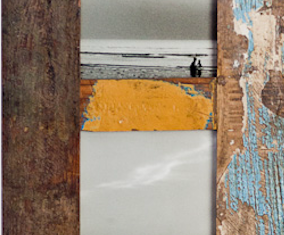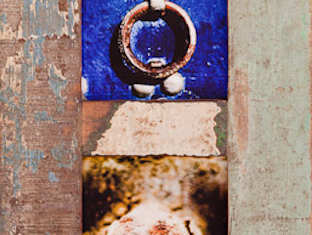SCRAPS, what’s left
Postdated images and only today developed/detected. “Detector” was the name of the developing bath in the darkroom. This is what’s left of trips, extended or improvised experiences outside the environment in which I was born, and in which I grew up in. This work has just an expression purpose, not a communication nor a documentation one. It is a mapping of my inner links, deprived of any descriptive intention regarding places and people.
The images of this project are inside special objects, even I don’t know exactly what holds what. They are boards, unique pieces, unrepeatable and unreproducible, that with the pictures create little chromatic or thematic stories. These frames, although the term is quite reductive, are the boards that for decades were the panels of the freight trucks that used to cross the borders of most of Asia, from Iran to Bangladesh, from Tibet to Sri Lanka. Those trucks have become endangered pachyderms, there are basically no more left on the streets. Those same boards made of Tek, Mango and Acacia trees, besides freight have also carried me, many times, thanks to the kindness of the truck-drivers that would give me a ride. I could have not desired a bigger privilege for these images, and for me as well, to be carried once again by them or vice versa.
I have always been attracted by exotism, and I have always fought with this weakness, ancient as human being: exotism is a seductive veil that hides reality, it’s not hard to identify in exotism a postulate of ignorance. But wonder is a state of grace that arises only from a condition of ignorance, of a preexistent unknowledge. What we already know rarely causes amazement, unless our point of view has changed in time: this mutual influence between object and subject might mark out an important part of our small and difficult evolution towards our self-consciousness and of what surrounds us.
So, if these pictures were taken under an exotic spell, their detection, because of this project construction, was possible thanks to that mutual changing that happens with time and that changes both ourselves and things. The term SCRAPS, not lacking exotism as well, in English means discarded technical material that gains actual value, distant from its origin, if properly recycled.
SCRAPS - By Bruno Di Marino
The “scrap”, what’s left over, to which the series title refers, is not only a visual scrap, but also a material one. The boards suggest countless stories, bits of storytelling, where photography, throughout documentary, performance, experimentation and fiction, almost becomes film narrative.
The matter unfolds and articulates itself within different frames, following a non-linear structure, using a style that is mostly visually violent, bright, hyper-realistic, and in many cases almost tacky, as in Bollywood’s poster designing iconography. On the contrary, in other artworks made in black and white, prevails a realistic minimalism, that could easily be a tribute to the imaginary of directors such as Satyajit Ray or Abbas Kiarostami.
SCRAPS - by Oliviero Beha
A strange figure between the up-to-date Proteus and the Promethean craftsman, this Cabras. He uses the centrifuge of thought, mixed with glances of ethics and glances of aesthetics; Francesco can draw with his mind and take kaleidoscopic photographs that are sometimes indelible marks, but what if he loses himself in the realm of eccentricity, that is, if he strays from the centre?
The answer lies in the author. It is Cabras, the plane of encounter, of analytical synthesis, of research found and lost. It is never useless, it uses
of sense and meaning to manipulate the signifier, as one would say in the tavern of figuration.









































